Persimmon, Japanese persimmon, Kaki
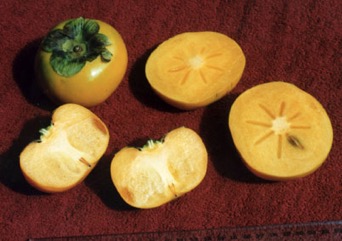
It suits cooler Mediterranean type climates. In the tropics it needs to grow in highland areas with a distinctly seasonal climate. Dormant trees can tolerate freezing temperatures. They have only a short (100 hours) chilling requirement. It needs 890 hours between 8-12°C during the dormant period. They will not tolerate acid soils. A pH of 6.5 to 7.5 is preferred. They can stand some waterlogging. It does best in well drained soils. Branches tend to be brittle and damaged by strong winds. In Nepal it grows to about 1200 m altitude. In Indonesia it grows above 1,000 m above sea level. In Yunnan in China it grows between 600-1800 m above sea level. It grows in secondary forest. It suits hardiness zones 8-10. In Brisbane Botanical Gardens. Arboretum Tasmania.
Also known as:
Abe, Bonnaga, Buah kaki, Buah samak, Cachi, Caqui, Dieng-iong, Gamnamu, Ganuong, Halawa bet, Halwa tendu, Hpun-mang sabyin, Kaki americano, Kakinoki, Kasemek, Kesemak, Kesemek, Khradashi, Komi, Mezhajiedi, Oriental persimmon, Phlap chin, Sa-nar-ni, Shi tree, Shishu, Soh-tang-jong, Sur amioke, Tae, Taw-te, Tayok-te, Te, Tel, Tendu pat, Thei manta, Theipan, Toor amluk, Trabzon hurmasi, Tunloab chen, Yaixihua, Ziar amlok
Synonyms
- Diospyros amara Perrier
- Diospyros argyi H. Lev.
- Diospyros bertii Andre
- Diospyros chinensis Blume [Invalid]
- Diospyros costata Carriere
- Diospyros kaki var. silvestris Makino
- and others
Edible Portion
- Fruit, Leaves - tea, Seeds - coffee
Where does Persimmon grow?
Found in: Afghanistan, Africa, Algeria, Armenia, Asia, Australia, Azerbaijan, Bangladesh, Brazil, Britain, Cambodia, Caucasus, China, Cook Islands, Cuba, East Africa, Egypt, France, Georgia, Hawaii, Himalayas, India, Indochina, Indonesia, Israel, Italy, Japan, Korea, Laos, Madagascar, Malaysia, Manchuria, Mediterranean, Mexico, Myanmar, Nepal, New Zealand, North Africa, North America, Northeastern India, Pacific, Pakistan, Palestine, Papua New Guinea, PNG, Philippines, Russia, SE Asia, Slovenia, South America, Spain, Taiwan, Tajikistan, Tasmania, Thailand, Turkey, United States, Vietnam
Notes: There are about 485 species of Diospyros mostly in the tropics. It is a polyploid. It is the national fruit of Japan. Fruit are high in folates 51μg/100.
Status: This tree has been introduced and tried in a few highland areas of Papua New Guinea but so far has not grown or fruited well. It is a cultivated fruit tree.
Growing Persimmon, Japanese persimmon, Kaki
Cultivation: They are grown from seeds. Seeds often germinate poorly. Trees grow slowly. Budded or grafted trees can be used. They can be grown by cuttings and air-layering. Trees can be pruned and shaped either along a wall or as a hedge. Pruning when trees are young to develop a strong framework of branches is important. Adequate moisture is needed during the year. Trees can grow and produce with minimal fertiliser. Trees often need cross pollination from another tree.
Edible Uses: The fruit is eaten raw or can be cooked. It needs to be fully ripe and soft. Freezing fruit overnight can improve sweetness. They are used in pies, puddings, cakes, bread, ice cream and other desserts. Fruit can be stored frozen. Fruit are used for wine and vinegar. The leaves are used to improve the flavour of pickled radishes. Roasted seeds are served as a coffee substitute.
Production: Fruiting is seasonal. Often trees bear large crops one year and small ones the next year. This can be evened out by thinning out some of the fruit is the high yielding years. Fruit should be cut from the branches cutting the stalk near the fruit. Fruit are often ripened by putting near other ripening fruit like banana. Fruit must be handled carefully to avoid bruising. Fruit can be stored in a refrigerator for one month. Higher yields are obtained if pollination occurs. Trees can live for 60-80 years. Fruit mature after about 200 days.
Nutrition Info
per 100g edible portion| Edible Part | Energy (kcal) | Protein (g) | Iron (mg) | Vitamin A (ug) | Vitamin c (mg) | Zinc (mg) | % Water |
|---|---|---|---|---|---|---|---|
| Fruit - raw | 70 | 0.58 | 0.2 | 217x | 7.5 | 0.1 | 80.3 |
| Fruit - dried | 274 | 1.38 | 0.7 | 56 | 0 | 0.4 | 23 |
Persimmon, Japanese persimmon, Kaki Photos

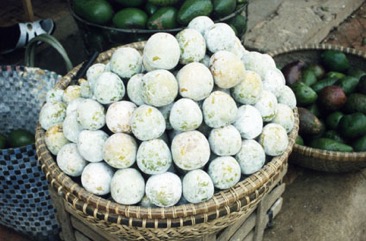
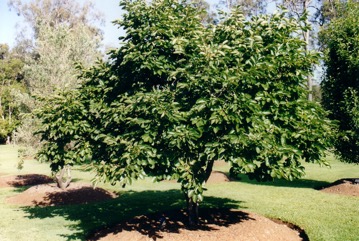
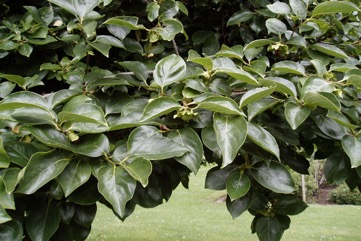
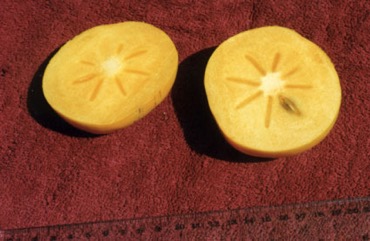
References
Kaki persimmon references
Ahmad, I., et al, 2011, Ethnobotanical Study of Tehsil Kabal, Swat District, KPK, Pakistan. Hindawi Publishing Corporation Journal of Botany Volume 2011, Article ID 368572, 9 pages
Ambasta, S.P. (Ed.), 2000, The Useful Plants of India. CSIR India. p 176
Anderson, E. F., 1993, Plants and people of the Golden Triangle. Dioscorides Press. p 209
Arora, R. K., 2014, Diversity in Underutilized Plant Species - An Asia-Pacific Perspective. Bioversity International. p 67
Aryal, K., Moe, A.T., Hein, P.P., Bay, Y.H.S., Htay, T., Aung, H.W., Shakya, B., Xuefei, Y., Shaoliang, Y. , 2020, Wild and non- cultivated edible plants and their contribution to local livelihoods in Putao, Myanmar. ICIMOD.
Barwick, M., 2004, Tropical and Subtropical Trees. A Worldwide Encyclopedic Guide. Thames and Hudson p 149
Bianchini, F., Corbetta, F., and Pistoia, M., 1975, Fruits of the Earth. Cassell. p 178
Blamey, M and Grey-Wilson, C., 2005, Wild flowers of the Mediterranean. A & C Black London. p 173
Bodkin, F., 1991, Encyclopedia Botanica. Cornstalk publishing, p 346
Bot. Mag. (Tokyo) 22:159. 1908 (As Diospyros kaki var. sylvestris)
Brickell, C. (Ed.), 1999, The Royal Horticultural Society A-Z Encyclopedia of Garden Plants. Convent Garden Books. p 370
Brouk, B., 1975, Plants Consumed by Man. Academic Press, London. p 193
Brown, D., 2002, The Royal Horticultural Society encyclopedia of Herbs and their uses. DK Books. p 195
Burkill, I.H., 1966, A Dictionary of the Economic Products of the Malay Peninsula. Ministry of Agriculture and Cooperatives, Kuala Lumpur, Malaysia. Vol 1 (A-H) p 844
Catalogus 110. 1823, nom. nudum (As Diospyros chinensis)
Chase, P. & Singh, O. P., 2016, Bioresources of Nagaland: A Case of Wild 4 Edible Fruits in Khonoma Village Forest. in J. Purkayastha (ed.), Bioprospecting of Indigenous Bioresources of North-East India. p 50
Cheifetz, A., (ed), 1999, 500 popular vegetables, herbs, fruits and nuts for Australian Gardeners. Random House p 189
Chen, B. & Qiu, Z., Consumer's Attitudes towards Edible Wild Plants, Ishikawa Prefecture, Japan. p 23 www.hindawi.com/journals/ijfr/aip/872413.pdf (As Diospyros kaki var. sylvestris)
Coombes, A.J., 2000, Trees. Dorling Kindersley Handbooks. p 138
Cull, B.W., 1995, Fruit Growing in Warm Climates. Reed. p 172
Cundall, P., (ed.), 2004, Gardening Australia: flora: the gardener's bible. ABC Books. p 503
Darley, J.J., 1993, Know and Enjoy Tropical Fruit. P & S Publishers. p 27
Dobriyal, M. J. R. & Dobriyal, R., 2014, Non Wood Forest Produce an Option for Ethnic Food and Nutritional Security in India. Int. J. of Usuf. Mngt. 15(1):17-37
Ertug, F, Yenen Bitkiler. Resimli Türkiye Florası -I- Flora of Turkey - Ethnobotany supplement
Etherington, K., & Imwold, D., (Eds), 2001, Botanica's Trees & Shrubs. The illustrated A-Z of over 8500 trees and shrubs. Random House, Australia. p 263
Ethnobotanical Study of Tehsil Kabal, Swat District, KPK, Pakistan, Table 1
Facciola, S., 1998, Cornucopia 2: a Source Book of Edible Plants. Kampong Publications, p 92
Flora reipublicae popularis sinicae.
Flora of Pakistan www.eFloras.org
Flowerdew, B., 2000, Complete Fruit Book. Kyle Cathie Ltd., London. p 139
French, B.R., 1986, Food Plants of Papua New Guinea, A Compendium. Asia Pacific Science Foundation p 288
Ghorbani, A., et al, 2012, A comparison of the wild food plant use knowledge of ethnic minorities in Naban River Watershed Nature Reserve, Yunnan, SW China. Journal of Ethnobiology and Ethnomedicine; 8:17
Gouldstone, S., 1983, Growing your own Food-bearing Plants in Australia. Macmillan p 122 (Also as Diospyros chinensis)
Hara, H., et al. 1978-1982. An enumeration of the flowering plants of Nepal.
Hedrick, U.P., 1919, (Ed.), Sturtevant's edible plants of the world. p 277
Heywood, V.H., Brummitt, R.K., Culham, A., and Seberg, O. 2007, Flowering Plant Families of the World. Royal Botanical Gardens, Kew. p 135
Hibbert, M., 2002, The Aussie Plant Finder 2002, Florilegium. p 87
Hu, Shiu-ying, 2005, Food Plants of China. The Chinese University Press. p 623
Huxley, ed. The new Royal Horticultural Society dictionary of gardening. 1992
Iwatsuki, K., et al. 1993-. Flora of Japan.
Jardin, C., 1970, List of Foods Used In Africa, FAO Nutrition Information Document Series No 2.p 133
Jayaraman, U., & Singh, V., 1987, A Census of Edible Species of Diospyros L. in India. J. Econ. Tax. Bot. Vol. 10 No. 2 pp 416-419
Jeeva, S., 2009, Horticultural potential of wild edible fruits used by the Khasi tribes of Meghalaya. Journal or Horticulture and Forestry Vol. 1(9) pp. 182-192
Jin, Chen et al, 1999, Ethnobotanical studies on Wild Edible Fruits in Southern Yunnan: Folk Names: Nutritional Value and Uses. Economic Botany 53(1) pp 2-14 (As Diospyros kaki var. sylvestris)
John, L., & Stevenson, V., 1979, The Complete Book of Fruit. Angus & Robertson p 227
Khan, D. & Shaukat, S.S., 2006, The Fruits of Pakistan: Diversity, Distribution, Trends of Production and Use. Int. J. Biol. Biotech., 3(3):463-499
Kiple, K.F. & Ornelas, K.C., (eds), 2000, The Cambridge World History of Food. CUP p 1833
Kuo, W. H. J., (Ed.) Taiwan's Ethnobotanical Database (1900-2000), http://tk.agron.ntu.edu.tw/ethnobot/DB1.htm
Lazarides, M., & B. Hince. 1993. CSIRO Handbook of Economic Plants of Australia.
Lembaga Biologi Nasional, 1977, Buah-Buahan, Balai Pustaka, Jakarta. p 70
Lord, E.E., & Willis, J.H., 1999, Shrubs and Trees for Australian gardens. Lothian. p 53
Lorenzi, H., Bacher, L., Lacerda, M. & Sartori, S., 2006, Brazilian Fruits & Cultivated Exotics. Sao Paulo, Instituto Plantarum de Estuados da Flora Ltda. p 401
Lyle, S., 2006, Discovering fruit and nuts. Land Links. p 181
Macmillan, H.F. (Revised Barlow, H.S., et al) 1991, Tropical Planting and Gardening. Sixth edition. Malayan Nature Society. Kuala Lumpur. p 314
Maituthisakul, P., et al, 2007, Assessment of phenolic content and free radical-scavenging capacity of some Thai indigenous plants. Food Chemistry 100: 1409-1418
Manandhar, N.P., 2002, Plants and People of Nepal. Timber Press. Portland, Oregon. p 203
Marinelli, J. (Ed), 2004, Plant. DK. p 102
Martin, F. W., et al, 1987, Perennial Edible Fruits of the Tropics. USDA Handbook 642 p 25
Medhi, P., Sarma, A and Borthakur, S. K., 2014, Wild edible plants from the Dima Hasao district of Assam, India. Pleione 8(1): 133-148
Meyer, F. G., et al. 1994. A catalog of cultivated woody plants of the southeastern United States. 65.
Miguel, E., et al, 1989, A checklist of the cultivated plants of Cuba. Kulturpflanze 37. 1989, 211-357
Morton, Julia F., 1987, Fruits of Warm Climates. Creative Resources Systems, Inc. . p. 411
Mozhui, R., et al, 2011, Wild edible fruits used by the tribals of Dimapur district of Nagaland, India. Pleione 5(1): 56 - 64.
Nova Acta Regiae Soc. Sci. Upsal. 3:208. 1780 - non D. kaki L. f. (1781)
Patiri, B. & Borah, A., 2007, Wild Edible Plants of Assam. Geethaki Publishers. p 79
Peekel, P.G., 1984, (Translation E.E.Henty), Flora of the Bismarck Archipelago for Naturalists, Division of Botany, Lae, PNG. p 432, 430
Pfoze, N. L., et al, 2012, Survey and assessment of floral diversity on wild edible plants from Senapati district of Manipur, Northeast India. Journal of Biodiversity and Environmental Sciences. 1(6):50-52
Pham-Hoang Ho, 1999, An Illustrated Flora of Vietnam. Nha Xuat Ban Tre. p 641
Phon, P., 2000, Plants used in Cambodia. © Pauline Dy Phon, Phnom Penh, Cambodia. p 240
Pieroni, A., 1999, Gathered wild food plants in the Upper Valley of the Serchio River (Garfagnana), Central Italy. Economic Botany 53(3) pp 327-341
Plants for a Future database, The Field, Penpol, Lostwithiel, Cornwall, PL22 0NG, UK. http://www.scs.leeds.ac.uk/pfaf/
Priyadi, H., et al, Five hundred plant species in Gunung Halimun Salak National Park West Java. A checklist including Sundanese names, distribution and use. CIFOR, FFPRI, SLU p 83
Rashid, H. E., 1977, Geography of Bangladesh. Westview. p 346
Recher, P, 2001, Fruit Spirit Botanical Gardens Plant Index. www.nrg.com.au/~recher/ seedlist.html p 2
Sarma, H., et al, 2010, Updated Estimates of Wild Edible and Threatened Plants of Assam: A Meta-analysis. International Journal of Botany 6(4): 414-423
Sawian, J. T., et al, 2007, Wild edible plants of Meghalaya, North-east India. Natural Product Radiance Vol. 6(5): p 415
Segura, S., et al, 2018, The edible fruit species in Mexico. Genet Resour Crop Evol (2018) 65:1767–1793
Self, M., 199, Phoenix Seeds catalogue. p 16
Sharma, B.B., 2005, Growing fruits and vegetables. Publications Division. Ministry of Information and broadcasting. India. p 117
Sher, H. et al, 2011, Ethnobotanical and Economic Observations of Some Plant Resources from the Northern Parts of Pakistan. Ethnobotany research & Applications 9:027-041
Sher, Z., Hussain, F., & Ibrar, M., 2014, Traditional knowledge on plant resources of Ashezai and Salarzai Valleys, District Buner, Pakistan. African Journal of Plant Science. Vol. 8(1), pp. 42-53, January 2014
Shin, T., et al, 2018, Traditional knowledge of wild edible plants with special emphasis on medicinal uses in Southern Shan State, Myanmar. Journal of Ethnobiology and Ethnomedicine (2018) 14:48
Shu-kang, L., Gilbert, M.G., & White, F., Ebenaceae. Flora of China.
Singh, H.B., Arora R.K., 1978, Wild edible Plants of India. Indian Council of Agricultural Research, New Delhi. p 55
Singh, V. B., et al, (Ed.) Horticulture for Sustainable Income and Environmental Protection. Vol. 1 p 215
Smith, K., 1998. Growing Uncommon Fruits and Vegetables. New Holland. p 89
Smith, P.M., 1979, Persimmon, in Simmonds, N.W., (ed), Crop Plant Evolution. Longmans. London. p 306
Solomon, C., 2001, Encyclopedia of Asian Food. New Holland. p 279
Staples, G.W. and Herbst, D.R., 2005, A tropical Garden Flora. Bishop Museum Press, Honolulu, Hawaii. p 272
Striegel, L., et al, 2019, Promising Tropical Fruits High in Folates. Foods 2019, 8, 363; doi:10.3390/foods8090363. www.mdpi.com/journal/foods
Suwardi, A. B., et al, 2020, Wild edible fruits generate substantial income for local people of the Gunung Leuser National Park, Aceh Tamiang Region. Ethnobotany Research & Applications 20:11
Tankard, G., 1990, Tropical fruit. An Australian Guide to Growing and using exotic fruit. Viking p 86
Tate, D., 1999, Tropical Fruit. Archipelago Press. Singapore. p 58
Terrell et al. 1986. Agric. Handb. no. 505.
USDA, ARS, National Genetic Resources Program. Germplasm Resources Information Network - (GRIN). [Online Database] National Germplasm Resources Laboratory, Beltsville, Maryland. Available: www.ars-grin.gov/cgi-bin/npgs/html/econ.pl (10 April 2000)
Valder, P., 1999, The Garden Plants of China. Florilegium. p 280
van Wyk, B., 2005, Food Plants of the World. An illustrated guide. Timber press. p 180
Verheij, E. W. M., and R. E. Coronel, eds. 1991. Edible fruits and nuts. In: E. W. M. Verheij & R. E. Coronel (eds.), Plant Resources of South-East Asia (PROSEA). 2:154.
Wild edible plants of Himachal Pradesh
World Checklist of Useful Plant Species 2020. Royal Botanic Gardens, Kew
www.worldagroforestrycentre.org/sea/products/afdbases/af
Zawiah, N. & Othaman, H., 2012, 99 Spesies Buah di FRIM. Institut Penyelidikan Perhutanan Malaysia. p 98